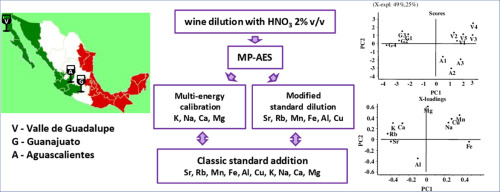当前位置:
X-MOL 学术
›
Spectrochim. Acta B. At. Spectrosc.
›
论文详情
Our official English website, www.x-mol.net, welcomes your feedback! (Note: you will need to create a separate account there.)
Determination of major and minor elements in Mexican red wines by microwave-induced plasma optical emission spectrometry, evaluating different calibration methods and exploring potential of the obtained data in the assessment of wine provenance
Spectrochimica Acta Part B: Atomic Spectroscopy ( IF 3.3 ) Pub Date : 2020-02-01 , DOI: 10.1016/j.sab.2019.105754 Tania Lizeth Espinoza Cruz , Moises Guerrero Esperanza , Kazimierz Wrobel , Eunice Yanez Barrientos , Francisco Javier Acevedo Aguilar , Katarzyna Wrobel
Spectrochimica Acta Part B: Atomic Spectroscopy ( IF 3.3 ) Pub Date : 2020-02-01 , DOI: 10.1016/j.sab.2019.105754 Tania Lizeth Espinoza Cruz , Moises Guerrero Esperanza , Kazimierz Wrobel , Eunice Yanez Barrientos , Francisco Javier Acevedo Aguilar , Katarzyna Wrobel

|
Abstract In this work, the determination of major and trace elements in Mexican wines was carried out by microwave-induced plasma optical emission spectrometry (MIP OES), setting sample dilution as the pretreatment procedure. The elements were grouped according with the required dilution fold: 1:100 for K; 1:50 for Na, Mg, Ca; 1:10 for Rb, Sr, Mn, Fe, Al and 1:4 for Cu, Cr. Due to troublesome background noise, different for each sample, matrix-matching with individual wines was necessary and three quantification methods were explored: classic standard additions (SA), standard dilution analysis (SDA) and multi-energy calibration (MEC). In order to avoid extrapolation in assessing the actual concentration of internal standard at each dilution point and to allow for longer integration time during signal acquisition, SDA was modified (nominated MSDA) and was recommended for the determination of minor elements whereas for major elements the suitable method was MEC. The results obtained by MSDA and MEC were in good agreement with those provided by SA; however, background correction was not required and both methods offer more simplicity as compared to SA. The concentration ranges found in the Mexican wines were as follows: 866–4896 mg L−1 K, 32.7–326 mg L−1 Na, 56.6–164 mg L−1 Mg, 63.9–121 mg L−1 Ca, 0.56–1.90 mg L−1 Sr, 0.35–6.31 mg L−1 Rb, 0.21–2.11 mg L−1 Fe, 0.69–1.72 mg L−1 Mn, 0.28–0.78 mg L−1 Al, 0.10–0.42 mg L−1 Cu, and Cr was not detected. Principal component analysis (PCA) allowed for separation of wines according with the winery regions: Valle de Guadalupe, Guanajuato, Aguascalientes. Furthermore, PCA revealed association of Rb, K, Ca, Sr with wines produced in Guanajuato and association of Na, Cu and Mn with those produced in Valle de Guadalupe; wines from Aguascalientes contained relatively high concentration of Fe and Al, although tight clustering of variables was not observed in this case. To establish reliable discrimination model, more samples from these and possibly from other winery regions in Mexico need to be analyzed.
中文翻译:

微波诱导等离子体发射光谱法测定墨西哥红葡萄酒中的主要和次要元素,评估不同的校准方法并探索获得的数据在葡萄酒产地评估中的潜力
摘要 本研究以样品稀释为前处理程序,采用微波诱导等离子体发射光谱法(MIP OES)测定墨西哥葡萄酒中的主量元素和微量元素。元素根据所需的稀释倍数进行分组:K 为 1:100;Na、Mg、Ca 1:50;Rb、Sr、Mn、Fe、Al 为 1:10,Cu、Cr 为 1:4。由于背景噪音麻烦,每个样品都不同,因此需要与个别葡萄酒进行基质匹配,并探索了三种定量方法:经典标准添加 (SA)、标准稀释分析 (SDA) 和多能量校准 (MEC)。为了避免在评估每个稀释点内标的实际浓度时进行外推,并在信号采集期间允许更长的积分时间,SDA 进行了修改(命名为 MSDA)并推荐用于测定微量元素,而对于主要元素,合适的方法是 MEC。MSDA和MEC得到的结果与SA提供的结果吻合良好;然而,不需要背景校正,与 SA 相比,这两种方法都提供了更简单的方法。在墨西哥葡萄酒中发现的浓度范围如下:866-4896 mg L-1 K、32.7-326 mg L-1 Na、56.6-164 mg L-1 Mg、63.9-121 mg L-1 Ca、0.56- 1.90 mg L-1 Sr、0.35-6.31 mg L-1 Rb、0.21-2.11 mg L-1 Fe、0.69-1.72 mg L-1 Mn、0.28-0.78 mg L-1 Al、0.10-0.42 mg L-1未检测到 Cu 和 Cr。主成分分析 (PCA) 允许根据葡萄酒产区分离葡萄酒:瓜达卢佩山谷、瓜纳华托、阿瓜斯卡连特斯。此外,PCA 揭示了 Rb、K、Ca、Sr 与瓜纳华托生产的葡萄酒以及 Na、Cu 和 Mn 与 Valle de Guadalupe 生产的葡萄酒的结合;来自阿瓜斯卡连特斯的葡萄酒含有相对较高浓度的铁和铝,尽管在这种情况下没有观察到变量的紧密聚集。为了建立可靠的判别模型,需要分析更多来自这些以及可能来自墨西哥其他酿酒区的样本。
更新日期:2020-02-01
中文翻译:

微波诱导等离子体发射光谱法测定墨西哥红葡萄酒中的主要和次要元素,评估不同的校准方法并探索获得的数据在葡萄酒产地评估中的潜力
摘要 本研究以样品稀释为前处理程序,采用微波诱导等离子体发射光谱法(MIP OES)测定墨西哥葡萄酒中的主量元素和微量元素。元素根据所需的稀释倍数进行分组:K 为 1:100;Na、Mg、Ca 1:50;Rb、Sr、Mn、Fe、Al 为 1:10,Cu、Cr 为 1:4。由于背景噪音麻烦,每个样品都不同,因此需要与个别葡萄酒进行基质匹配,并探索了三种定量方法:经典标准添加 (SA)、标准稀释分析 (SDA) 和多能量校准 (MEC)。为了避免在评估每个稀释点内标的实际浓度时进行外推,并在信号采集期间允许更长的积分时间,SDA 进行了修改(命名为 MSDA)并推荐用于测定微量元素,而对于主要元素,合适的方法是 MEC。MSDA和MEC得到的结果与SA提供的结果吻合良好;然而,不需要背景校正,与 SA 相比,这两种方法都提供了更简单的方法。在墨西哥葡萄酒中发现的浓度范围如下:866-4896 mg L-1 K、32.7-326 mg L-1 Na、56.6-164 mg L-1 Mg、63.9-121 mg L-1 Ca、0.56- 1.90 mg L-1 Sr、0.35-6.31 mg L-1 Rb、0.21-2.11 mg L-1 Fe、0.69-1.72 mg L-1 Mn、0.28-0.78 mg L-1 Al、0.10-0.42 mg L-1未检测到 Cu 和 Cr。主成分分析 (PCA) 允许根据葡萄酒产区分离葡萄酒:瓜达卢佩山谷、瓜纳华托、阿瓜斯卡连特斯。此外,PCA 揭示了 Rb、K、Ca、Sr 与瓜纳华托生产的葡萄酒以及 Na、Cu 和 Mn 与 Valle de Guadalupe 生产的葡萄酒的结合;来自阿瓜斯卡连特斯的葡萄酒含有相对较高浓度的铁和铝,尽管在这种情况下没有观察到变量的紧密聚集。为了建立可靠的判别模型,需要分析更多来自这些以及可能来自墨西哥其他酿酒区的样本。


























 京公网安备 11010802027423号
京公网安备 11010802027423号